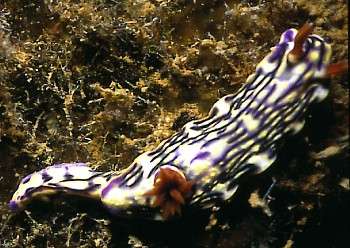
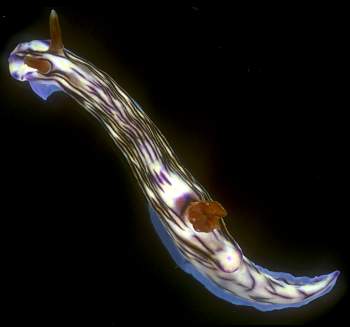
Hypselodoris zephyra
Gosliner & Johnson, 1999
Order: NUDIBRANCHIA
Suborder: DORIDINA
Superfamily: EUDORIDOIDEA
Family: Chromodorididae
DISTRIBUTION
Known from western and central Pacific.
PHOTO
UPPER: Espiritu Santo Is., Vanuatu, 3 metres. 1993. PHOTO: Vinka Stenhouse.
LOWER: Coffs Harbour Region, northern new South Wales, Australia. December 1990. PHOTO: Bill Rudman.
Similar to Hypselodoris nigrostriata but in this species the black lines are parallel rather than oblique. The purple marks can sometimes be lines. The gills are simple, not triangular in cross section.
Reference:
• Gosliner, T.M. & Johnson, R.F. (1999) Phylogeny of Hypselodoris (Nudibranchia: Chromodorididae) with a review of the monophyletic clade of Indo-Pacific species, including descriptions of twelve new species. Zoological Journal of the Linnean Society, 125: 1-114.
Rudman, W.B., 2000 (March 21) Hypselodoris zephyra Gosliner & Johnson, 1999. [In] Sea Slug Forum. Australian Museum, Sydney. Available from http://www.seaslugforum.net/find/hypszeph
Related messages
Re: Hypselodoris zephyra feeding
September 4, 2008
From: Barbara Hanchard
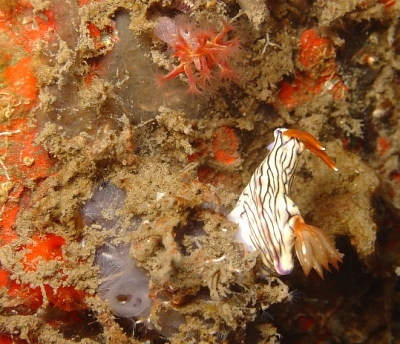
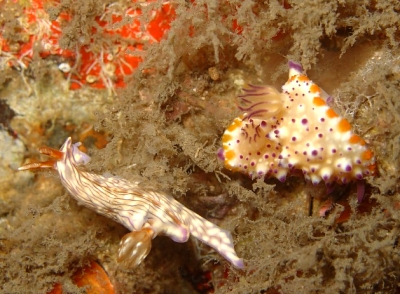
Concerning message #21848:
Dear Bill,
Yes I was fairly certain that was an egg ribbon....just my very warped sense of humour there. Tamara and I are still living off the nudi toilet humour generated by my mistake. I won't blame Tamara for this as she is fairly new to the nudibranch obsession.
Anyway, thank you for your detailed response it was most helpful. I went back to look at other photos to see if I had one that showed a fibrous skeleton or a clearer reticulate pattern of fibers of what you think might be a dysideid sponge and the attached photo might be slightly better definition. A portion of the sponge to the left of the Hypselodoris zephyra is raised in a cone shape. I think I mentioned earlier that at the time these photos were taken the wreck had only been underwater for 4 months which would perhaps explain why the colony was too thin 'to study the layers and arrangement of the fibre bundles' as they were probably in the early stages of growth.
Locality: Tommy Chan Wreck, Ranadi, 35 meters, Solomon Islands, Pacific Ocean, 12 January 2006, Wreck. Length: 30mm. Photographer: N.Barbara Hanchard.
I know we are not suppose to throw other species into the mix but I thought I would also show you another of the chromodrorid also found in numbers along side the H. zephyra. Particularly, as there also seems to be some feeding information on the Forum for Mexichromis multituberculata (specifically Mike Krampf's message #20416 ).
Barbara
barbara.hanchard@ffa.int
Hanchard, N.B., 2008 (Sep 4) Re: Hypselodoris zephyra feeding. [Message in] Sea Slug Forum. Australian Museum, Sydney. Available from http://www.seaslugforum.net/find/21863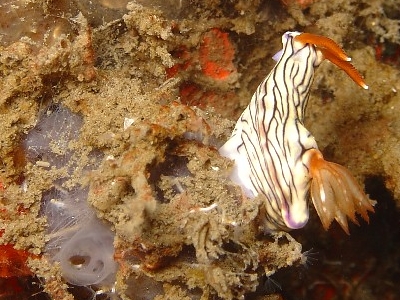
Dear Barbara,
Thanks for persisting with the sponge mystery. As I mentioned in Mike Krampf's message, I welcome 'multi-species' messages like this where the fact that the species are together is the point of the message. Mexichromis multituberculata is proving to be an excellent 'indicator' species because it seems to feed only on species of the dysideid genus Euryspongia and it is often found with other chromodorid species. In Mike Krampf's message it is with two other species, and in Ken Tucker's message [#20161] it is with one other. I think we can be pretty sure that if we find Mexichromis multituberculata and other chromodorids feeding together, then their food will be Euryspongia, or at least a dysideid.
From this and your earlier messages, I looks like Hypselodoris zephyra and H. krakatoa both feed on a species of Euryspongia.
Best wishes,
Bill Rudman
Re: Hypselodoris zephyra feeding
September 2, 2008
From: N. Barbara Hanchard

Dear Bill,
Hypselodoris zephyra or H. nigrostriata? Sorry I couldn't quite follow the debate about the differentiation in gills (simple & triangular in cross section).
This is one of the other species found on the same wreck as my H. krakatoa was found on back in 2006. You will recall I said I found several other species all on the same site [message #21834 ].
Thought you might also like the photo of one of them laying eggs (least I hope they are eggs unlike my embarrassing error with H. batangas [#21833 ].
Locality: Tommy Chan Wreck, Ranadi, 35 meters, Honiara, Solomon Islands, Pacific Ocean, 12 January 2006, Wreck. Length: 35mm. Photographer: N.Barbara Hanchard.
Barbara
barbara.hanchard@ffa.int


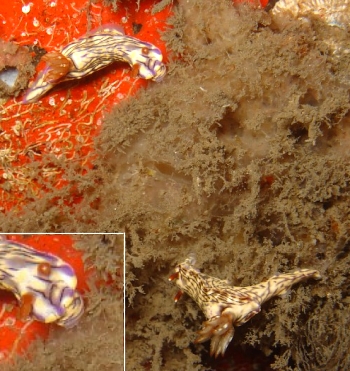
Dear Barbara,
Yes this is definitely an egg ribbon. If you look carefully you can see the individual white eggs. Your photos also confirm that the greyish 'coating' the chromodorids are interested in is a sponge. In the enlarged inset I have added to your photo alongside, you can see the oral tube is extended in its feeding position. In your earlier photos with H. krakatoa I could not see any signs of a fibrous skeleton in the 'sponge' but in the enlargement [middle left photo] a distinct reticulate pattern of fibres is visible. It is similar to that in the dysideid sponge being eaten by H. zephyra in an earlier message [#19789].
I can't be 100% sure that the sponge is a dysideid, as the photo is not that clear, but it is what I would call 'a pretty good indication'. It is another example of how difficult it is to identify the food of some of these animals. Even if I had been there, I suspect the layer of sponge would have been too thin to make a confident field identification, and probably too thin to take a worthwhile sample for laboratory identification, for identifying this group of sponges which lack identifiable skeletal spicules, requires a sample which allows us to study the layers and arrangement of the fibre bundles, and in such a thin layer the structure of the colony would not have been developed sufficiently. I guess this give us another bit of evidence that H. krakatoa feeds on dysideid sponges, but we really need something a bit more concrete.
Concerning the difference between H. zephyra and H. nigrostriata. There seem to be two external characters separating them. In H. zephyra the black lines are said to be parallel while in H. nigrostriata they are often diagonal. Also the gills of H. nigrostriata are triangular in cross-section - that is if you cut a gill in half and looked at it end on it would be a triangle. This means that the whole gill is three-sided, the two sides facing inwards have gill leaflets on them while the side facing outwards is smooth with an orange line up each edge. In H. zephyra the gills are said to be 'simple' in that they only have two sides, each with gill leaflets. One edge of the gill faces in and the other faces out. There are a whole group of chromodorids with 'simple' gills like this. In the photos on the Forum of these two species, very few seem to have 'simple' gills. Even a photo of mine [#9445] which looks 'simple' could be triangular. In your photos, the gills are clearly triangular. More troubling is that one of your animals seems to have diagonal lines while the other has parallel lines. As I have said elsewhere on these pages I have trouble separating these species and am not 100% convinced they are two species. I have placed yours with H. zephyra, but I suspect I should be courageous and consider them to be a single species.
Best wishes,
Bill Rudman
Re: Hypselodoris zephyra feeding
November 23, 2007
From: Philip Cromwell
Concerning message #21115:
Hi Bill,
On the Factsheet for Hypselodoris zephyra you mention that the "gills are simple, not triangular in cross section." While on the H. nigrostriata Factsheet you mention that "the rhinophores are orange red and the gills, triangular in cross-section are edged with the same colour." It seems that if the gills are a defining characteristic, and they are different, then this specimen would be H. nigrostriata.
Just some thoughts.
Thanks,
Phil
aegir429@yahoo.com
Cromwell, P. A., 2007 (Nov 23) Re: Hypselodoris zephyra feeding. [Message in] Sea Slug Forum. Australian Museum, Sydney. Available from http://www.seaslugforum.net/find/21119Dear Phil,
Thanks for raising this problem again. I discussed this in answer to your earlier comments [message #9288] but my assumption that H. zephyra had simple gills was based on the original description of the species where they are described as 'simple'. However on checking most of the photos of these two 'species' on the Forum I see my earlier enthusiasm for separating them was probably misplaced as most of those I have sorted as H. zephyra have gills which are clearly triangular in cross-section. I suspect we probably have a single species which varies slightly in colour pattern across its vast geographic range. The other possibility is that there are two species, but unfortunately in photos of animals which seem to have simple gills, the gills always are out of focus so I can't be sure.
Best wishes,
Bill Rudman
Hypselodoris zephyra feeding
November 14, 2007
From: Erwin Kodiat
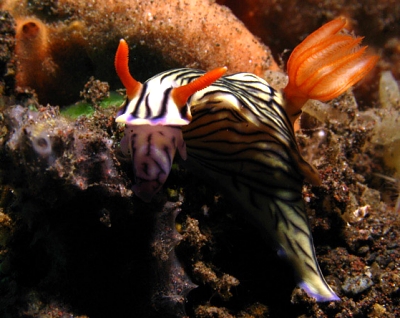
Hi Bill,
I found this might be interesting for you. A Hypselodoris nigrostriata feeding on sponges (?).
Locality: Seraya, 10 meters, Bali, Indonesia, Lombok Sea, 10 November 2007, Patches. Length: 40 mm. Photographer: Erwin Kodiat.
Erwin Kodiat
info@nudipixel.net
Kodiat, E., 2007 (Nov 14) Hypselodoris zephyra feeding. [Message in] Sea Slug Forum. Australian Museum, Sydney. Available from http://www.seaslugforum.net/find/21115
Dear Erwin,
Thanks for this. It is certainly feeding as it has its large colorful oral tube everted. However if Hypselodoris nigrostriata and Hypselodoris zephyra are different species, and I sometimes wonder, then your animal is best identified as H. zephyra, because the black lines tend to run parallel to each other rather than cross over.
I'm afraid the resolution of your photo is not detailed enough for me to see enough detail to identify the sponge but I suspect it is the species of Dysidea illustrated in Dave Mullins' message I posted yesterday [#21093].
Best wishes,
Bill Rudman
Re: Hypselodoris zephyra - feeding observations
November 13, 2007
From: David Mullins
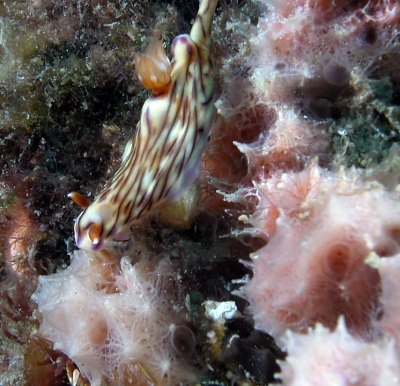
Concerning message #19789:
Dear Bill,
I just thought I would follow up on Bruce Wilkie's message [#19789] in order to provide the forum a back up record of the feeding preference of Hypselodoris zephyra.
These pics are sequential and depict the one specimen feeding on the same sponge.
Locality: Eastern side, Old Woman Island (Mudjimba Island) Maroochydore,, 10 metres, Queensland, Australia., Pacific Ocean., 18 September 2005, Rocky reef. Length: 25 mm. Photographer: David Mullins.
Bill, our "branching" excursions now seem to involve much more than documenting as many species as possible. It is now just as much about recording their natural history making each mission in "our backyard" more of a challenge.
Kind regards,
David Mullins.
david@nudibranch.com.au
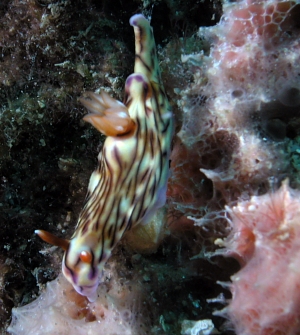
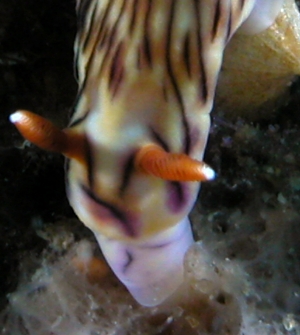

Dear David,
Thanks for another record of this species feeding. I wish they all picked such obvious sponge colonies to eat. Your comment concerning your dives becoming missons in natural history discovery is music to my ears. One of the aims of the forum has been to make everyone who is interested in these fascinating animals aware that there is still much to learn about their biology and natural history - and that anyone, with an interest, a good eye and some background information, can discover new information about them.
Best wishes,
Bill Rudman
Hypselodoris zephyra - feeding observations
April 2, 2007
From: Bruce Wilkie
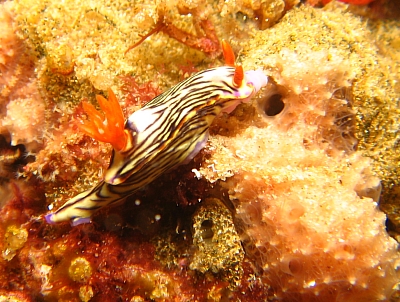
Hi Bill,
I have been looking through the Forum and you don`t appear to have feeding records of Hypselodoris zephyra. I have included 3 feeding photo`s for your records. I hope you are able to id the sponges.
Locality: Upper photo [cream sponge] Flat Rock North Stradbroke Island, 14 metres, Queensland Australia, Pacific ocean, 11 March 2007, rocky reef with sponges, hard & soft corals . Length: 25mm. Lower photo [pinkish sponge] Manta bommie, North Stradbroke Island, 10 metres, Queensland Australia, Pacific ocean, 23 December 2006, rocky reef with sponges, hard & soft corals . Length: 20 mm. Photographer: Bruce Wilkie.
Many Thanks,
Bruce Wilkie.
brucedwilkie@yahoo.com.au
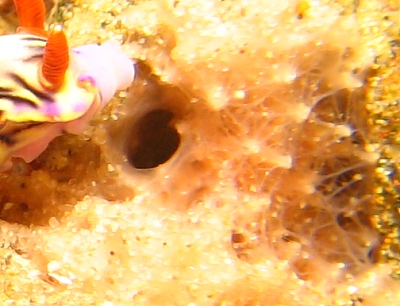

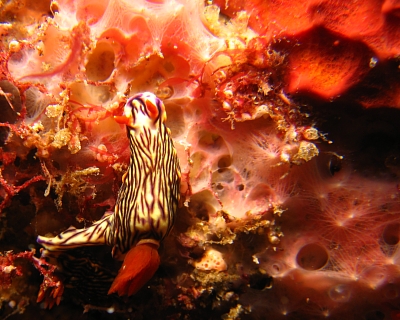
Dear Bruce,
Thanks very much for these records. I have only included two of your photos, as I am not sure what the third 'sponge' is - it may be an ascidian. The other two are excellent examples of the sponge genus Dysidea. They certainly improve on Erwin Kodiat's tantalising photo in which we can see the colourful oral tube everted [message #15445] but no sponge is visible.
Best wishes,
Bill Rudman
Hypselodoris zephyra? from North Sulawesi
May 29, 2006
From: Jack Connick
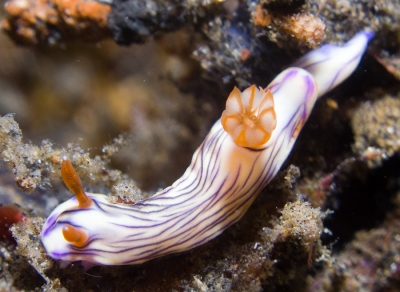
Hi Bill;
Just back from 15 days in North Sulawesi. I shot this in Lemba Strait and believe it might be Hypselodoris zephyra, but could use an expert opinion.
Locality: Lemba Strait, 15 metres, North Sulawesi, Indonesia, Rosario Strait, 05 May 2006, rocky outcropping, sandy bottom. Length: 5". Photographer: Jack Connick.
Jack Connick
JackConnick@Yahoo.com
Connick, J., 2006 (May 29) Hypselodoris zephyra? from North Sulawesi. [Message in] Sea Slug Forum. Australian Museum, Sydney. Available from http://www.seaslugforum.net/find/16706Dear Jack,
Yes I would tend to agree with your identification, but as I discuss a number of times on the Forum, the difference between this species, with mainly parallel dark lines and Hypselodoris nigrostriata, with diagonal dark lines, is slight. Your animal, with some diagonal lines illustrates the problem.
Best wishes,
Bill Rudman
Hypselodoris zephyra feeding
December 19, 2005
From: Erwin Kodiat
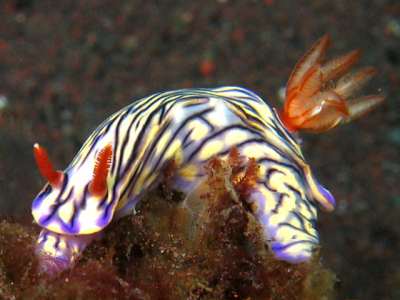
Hi Bill,
Can't find the scientific name of this species. It was found abundantly in Seraya, Bali and also Tulamben.
Locality: Seraya, Bali, Indonesia. Lombok Strait. Depth: 10 meters. Length: 40 mm. 24 November 2005. Sandy. Photographer: Erwin Kodiat
Can you help me ID this? Thanks.
Erwin Kodiat
ungu@terong.com
Erwin Kodiat, 2005 (Dec 19) Hypselodoris zephyra feeding. [Message in] Sea Slug Forum. Australian Museum, Sydney. Available from http://www.seaslugforum.net/find/15445Dear Erwin,
This is Hypselodoris zephyra. It is very similar to H. nigrostriata but differs in having the black lines attanged longitudinally rather than diagonally, but at times I have difficulty separating them from photos. You can see from the extended oral tube that it is feeding, but unfortunately the sponge it is eating is hidden by surface growths. In many species the oral tube has the same colour pattern as the body, but it is only everted - and visible - when the animal is feeding.
Best wishes,
Bill Rudman
Hypselodoris zephyra on the Sunshine Coast
December 3, 2003
From: Gary Cobb

Hi Bill!
Please find attached what I think is Hypselodoris zephyra I found on top of the wall off Old Woman Island, Sunshine Coast, Queensland, Australia. The whole area it was found was broken shells, coral and small rocks as in the photo.
Depth: 6m
Temp: 22C
Length: 40mm
Date: 29-11-03
Gary Cobb
gary@cobb.com.au
Cobb, G., 2003 (Dec 3) Hypselodoris zephyra on the Sunshine Coast. [Message in] Sea Slug Forum. Australian Museum, Sydney. Available from http://www.seaslugforum.net/find/11570Dear Gary,
As I have discussed a number of times in the Forum I still have some doubts about the differences between Hypselodoris zephyra and Hypselodoris nigrostriata If they are different I guess this is Hypselodoris zephyra.
Best wishes,
Bill Rudman
Re: Hypselodoris nigrostriata from Bali
March 21, 2003
From: Phil Cromwell
Bill,
In Danny Van Belle's message you distinguish Hypselodoris nigrostriata and Hypselodoris zephyra by saying the latter has simple gills while the former has gills which are triangular in cross-section. If this is so, it seems that several photos on the Hypselodoris zephyra page need to be reviewed.
Thanks,
Phil
chiron42@msn.com
Dear Phil,
Yes I do need to revisit these messages. I have had difficulty in separating these two species since H. zephyra was described, partly because the gills have not always been clear in photos and the colour patterns of the two species tend to overlap. With more material now available I feel more confident in separating the two, so I am shifting quite a few of the animals I identified as H. zephyra across to H. nigrostriata. I must say that I am still not sure of some of the photos. I have also added a couple of new records of H. zephyra from eastern Australia.
Best wishes,
Bill Rudman
Hypselodoris zephyra off North Queensland
March 21, 2003
From: Mikkel Mowinckel
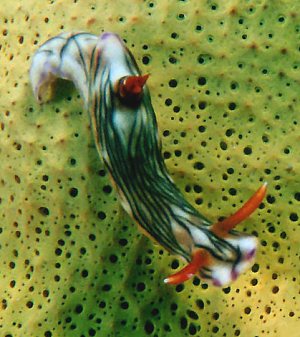
I took a picture of this little fella, who I think is a chromodorid, off Maureen's Cove on Hook Island, Whitsundays, North Queensland [east coast, Australia]. Approx 25mm long. He was trailing the mud, so I put him on a sponge for the picture's sake. I haven't been able to ID him quite yet and was hoping someone's give me a little hand.
Cheers,
Mikkel
mikkel.mowinckel@jcu.edu.au
Mowinckel, M., 2003 (Mar 21) Hypselodoris zephyra off North Queensland. [Message in] Sea Slug Forum. Australian Museum, Sydney. Available from http://www.seaslugforum.net/find/9336Dear Mikkel,
This is indeed a chromodorid. It is Hypselodoris zephyra. I'm glad you mentioned you put it on the sponge. I'm always on the lookout for feeding information, so I'll cross this off as a potential food source. Best wishes,
Bill Rudman
Hypselodoris zephyra from northern New South Wales (1)
March 21, 2003
From: Bill Rudman

To accompany my reorganisation of the Hypselodoris zephyra and Hypselodoris nigrostriata pages here are some photos of a specimen of Hypselodoris zephyra from northern New South Wales, Australia. The lower two photos are close-ups to show colour detail.
Coffs Harbour Region, northern new South Wales, Australia. December 1990. PHOTO: Bill Rudman
Best wishes
Bill Rudman
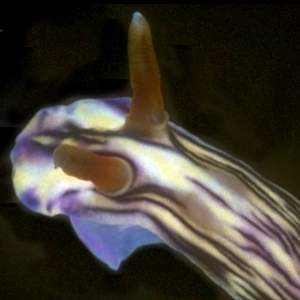
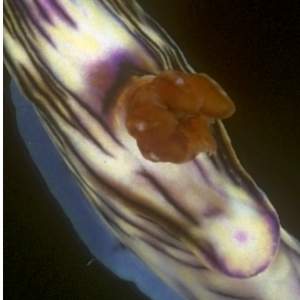
Hypselodoris zephyra from northern New South Wales (2)
March 21, 2003
From: Bill Rudman
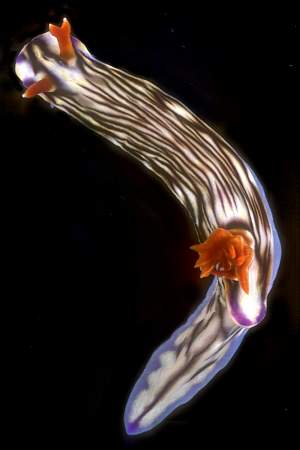
To accompany my reorganisation of the Hypselodoris zephyra and Hypselodoris nigrostriata pages here are some photos of another specimen of Hypselodoris zephyra from northern New South Wales, Australia. The lower two close-ups are to show colour detail. Note the bifid rhinophore.
Groper Is, Coffs Harbour Region, northern New South Wales, Australia. March 1988. AM C155773 PHOTO: Bill Rudman
Bill Rudman
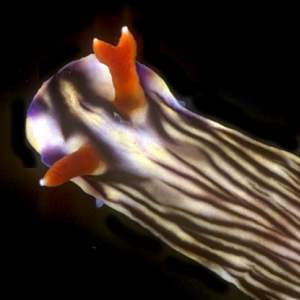

Hypselodoris zephyra from Vanuatu
February 14, 2003
From: Vinka Stenhouse

Hello Bill
After quite a while of not contacting you I have finally got around to sending some images to you. This one was found on a pier pylon at about 3 metres depth in 1993 at Santo, Vanuatu. Could you please identify it for me.
Vinka
vinkas@oceanaphotography.com
Stenhouse, V., 2003 (Feb 14) Hypselodoris zephyra from Vanuatu. [Message in] Sea Slug Forum. Australian Museum, Sydney. Available from http://www.seaslugforum.net/find/9190Thanks Vinka,
This is another example of Hypselodoris zephyra.
Best wishes,
Bill Rudman
Hypselodoris zephyra from Indonesia
January 22, 2003
From: Alice Lee

This nudibranch photo was taken at Nudi Retreat, Lembeh, North Sulawesi, Indonesia
Depth: 10m
Date: 1 January 2003
Could you please identify it.
Thanks,
Alice Lee
alee@dlink.com.sg
Lee, A., 2003 (Jan 22) Hypselodoris zephyra from Indonesia. [Message in] Sea Slug Forum. Australian Museum, Sydney. Available from http://www.seaslugforum.net/find/8928Dear Alice,
I am pretty sure this is Hypselodoris zephyra.
Best wishes,
Bill Rudman
Hypselodoris zephyra from South Japan
January 24, 2001
From: Mizuho

Dear Bill,
I again send a photo of a species I could not identify. It looks like Hypselodoris zephyra, but I am not sure.
Information:
Bonotsu, Kagoshima, South Japan, November 2000, Water Temp 23C, Depth 15m, in a dent of a rock wall.
Mizuho
iwa@fc4.so-net.ne.jp
Mizuho, 2001 (Jan 24) Hypselodoris zephyra from South Japan. [Message in] Sea Slug Forum. Australian Museum, Sydney. Available from http://www.seaslugforum.net/find/3599Dear Mizuho
It certainly looks like Hypselodoris zephyra but I am having some difficulty in finding a good external character to separate this species from Hypselodoris nigrostriata. On the whole, H. zephyra seems to have the lines on the body arranged longitudinally while in H. nigrostriata they are often diagonal. Also, in H. nigrostriata the gills are edged in orange and there are white patches along the outer face, while in H. zephyra the gills seems to be uniformly translucent orange.
On that basis I think you are best in identifying it as H. zephyra
Best wishes,
Bill Rudman.
Hypselodoris zephyra from Vanuatu
March 22, 2000
From: Vinka Stenhouse

Dear Bill,
Here is a nudibranch from Espiritu Santo Is., Vanuatu, 1993. It was in 3 meters depth
Yours sincerely,
Vinka Stenhouse.
Santo.
Vanuatu.
Dear Vinka,
This is Hypselodoris zephyra Gosliner & Johnson, 1999, which was only named last year.
Best wishes,
Bill Rudman.
